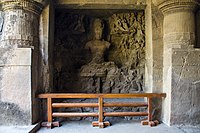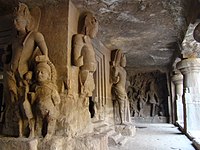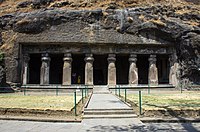Elephanta Island is an island off of Mumbai in Western India that is home to the Elephanta Caves, a UNESCO World Heritage site. It consists of a collection of cave temples predominantly dedicated to the Hindu god Shiva.
Understand


The island has been referred as Gharapuri (literally meaning village of caves) in ancient literature. The island covers an area of 1050 ha. The island consists of two hill separated by a narrow valley. The higher of the two hills rises to a height of 173 m above sea level.
The Portuguese named the island Elephanta, after a huge rock cut elephant statue found on the island. The elephant statue was damaged in attempts to relocate it to England, was moved to the Victoria Gardens (now Jijamata Udyaan) in 1864, was reassembled in 1914. Because of its strategic location at the mouth of the Thane Creek the island has served as an pit stop for ancient sailors dating back to the 2nd century BCE.
The caves, for which the island is famous, came up much later. Nothing much is known about the history of the caves. Numismatic evidence, along with inscriptions and construction style suggest that the caves were constructed by King Krishnaraja of the Kalachuri Dynasty and date back to the mid 6th century CE.
Today the grand sculptures of the cave are heavily damaged and defaced, it was not known when the destruction started. The most common theory states that the statues were damaged by the Portuguese soldiers as they used the caves and statues as a firing range and for target practice.
The island has a coastline of about 7 km and covers an area of 1050 hectors and the highest point rises to a height of 173 m above sea level. The island once had a share of mangrove forest but a large chunk of it has gone missing over the years.
Get in
The Elephanta Caves are located in the Elephanta Island about 11 km from mainland Mumbai. Ferry service is available from Apollo Bunder Jetty located next to Gateway of India, in South Mumbai.




- The ferry operates every half an hour
- The first ferry leaves Mumbai at 9:30AM
- The last ferry leaves Mumbai at 2PM
- The first ferry leaves Elephanta Island at noon
- The last ferry at 5:30PM
- The journey takes about an hour
- A roundtrip ticket cost ₹200. Payment of an extra ₹10 will provide a seat in the upper deck
- Elephanta Cave is closed on Monday




The journey is a remarkable experience and the ferry sails past the Mumbai harbour providing great views of the city skyline. The ferry also sails past huge ships from all over the world. Folks of seagulls are part of the journey. Tourists feeding these birds fried snacks causes serious damage on the birds' health and is illegal but the practice continues.
Get around


The ferry docks at the 1 Elephanta Island Pier., located on the northern side of the island. A toy train operaates along the pier taking visitors to the island. Tickets cost ₹10 for a round trip. However there is a option of walk also. On reaching the ground of the island a long flight of stairs leads the caves. There are about 120 steps and it is not very steep. There are souvenir and artifacts shops all along the way. The shops also sells guide book books, which provide ready reference about the history and mythology of the ancient caves.
Entry fees
- Entry tickets for citizen of India and SAARC (Afghanistan, Bangladesh, Bhutan, Maldives, Nepal, Pakistan and Sri Lanka) and BIMSTEC (Bangladesh, Bhutan, Nepal, Sri Lanka, Myanmar and Thailand) countries is ₹ 40 for other nationals it is ₹ 600. Children below 15 years have a free entry
- Videography charge: ₹ 25 per camera
- Still photography: Free
- Gram Panchayat Tax: ₹ 5 per visitor
Cave 1 is the largest and the grandest of the caves. Paid Guide services are available in the cave. Caves 2 - 5 are adjoining to the cave 1 and are nothing impressive. But since they are a short walk away it should not be given a miss. Cave 6 and 7 are located outside the walled complex. Located on the adjoining hill they are approachable by an unmarked trail. The hill also contains two Buddhist Stupas one unexcavated and one unexplored. Outside the walled complex and on the opposite side of Cave 6 and 7 are two huge cannons. They are reached in about 20 mins walk from the walled complex gate through a winding trail.
See






1 Cave 1. Cave 1 is the largest and the grandest of the Elephanta Caves. The cave consists of a central large hall flanked by the Eastern and Western courtyard. The main hall is approachable from the north and is supported by colossal columns. The hall also contains a small Shiva shrine. The southern wall of the hall contains three gigantic sculptures. The four corners of the main hall also has beautiful sculptures. The entrance is flanked by two sculptures on either side. On the left-hand side of the entrance is the statue of Yogishvara (Lord of Yogis) and on the right is Nataraja (Dancing Shiva).
Yogishvara (Lord of Yogis) (No 9 on Map): Located on the left of the entrance the panel shows Shiva seated in padmasana posture and lost in his meditation. Here the lord is represented as a master of the discipline of yoga, the teacher of Yoga arts. It is also known as Mahayogi or Lakulisa, the 28th incarnation of Shiva. He sits on a lotus with a stalk shown as if coming out of the earth, his legs are crossed symmetrically. He wears a crown and his expresses great spiritual strength and calmness. The statue is badly damaged with both the upper limbs completely broken. The background contains several smaller statues of gods and goddesses, as well as monks and sadhus, creating a complex collage. Although these statues are badly damaged but one can trace out Bramha, Indra and Vishnu riding their respective vehicles of swan, elephant and Garuda.
Nataraja (Dancing Shiva) (No 8 on Map): The panel of 'Nataraja Shiva lies on the right hand side of the main entrance and bang opposite the Yogishvara oanel. Here Shiva represents Nararaj or Nataraja, the king of the dancers. He is seen in lalita mudra. The panel is hevily damaged, with the entire lower portion totally missing. Large portions of the upper limbs have broken off. On the top left corner statues of Bramha, Parvati, Ganesha and Kartikeya can be spotted.
The entrance leads to a huge hall with a tall ceiling supported by a series of colossal columns and a shiva shrine on the left. The southern wall of the main hall houses three magnificent sculptures. On the centre is Trimurthi, on the left is Ardhanarishvara and on right is Gangadhara Shiva.
Trimurti (No. 4 on map): Trimurti or Mahesh Murti occupies the prime position of the Elephanta caves and no wonder is the star attraction of the cave. The sculpture has a width of 6.55 m and a height of 5.43 m and a depth of 3.2 m. It consists of a three headed statue of Shiva, identified as Mahesa, Mahadeva, or Sadasiva. Each face has its own expression, jewellery and headdress and represent three essential aspects of Shiva: creation, preservation, and destruction. The central face represents the Tatpursha or Mahadeva the creator. With eyes, almost closed in represents Shiva in deep meditation. The right face (left for viewer) represent Aghora, Bhairava or Rudra, the destroyer. The face exhibits curled moustache, bearded, hooked nose and somewhat gruesome appearance. The left head (right for viewers) represents Vamadeva, the preserver. With eyes almost closed it gives a peaceful look. The trimurti is flanked on both sides by statues of guardians deities, accompanied by a dwarf attendant.
Ardhanarishvara (No. 3 on map):.On the right of Trimurti (left for viewers) is the panel of Ardhanarishvara, literally meaning the half women god. The female part represents Parvati while the male part represents Shiva. The male part of the four handed statue leans on a bull (Nandi). The female part with a large breast is elegant with jewellery and hold a mirror in one hand. Numerous other figures crowd the background of the statue creating an elaborate backdrop.
Gangadhara Shiva (No. 5 in map):.This panel is located on the left of Trimurti (right for viewers). The panel represents the story of Lord Shiva bringing the River Ganges from heaven to earth. The panel shows Lord Shiva and Parvati standing side by side. In between them stands a gana (dwarf jester). Baghirath can be seen kneeling down on the lower left corner. Here also the background contains an amazing collection of minor sculptures, which include Bramha and Vishnu.
Shiva - Parvati dice game (No. 2 on map):This panel occupies the south east corner of the main hall of cave 1. The panel shows Shiva and Parvati engaged in a game of dice in Kailash. The scene, representing Kailash Mountain, includes rocky terrain and clouds layered horizontally. Sadly the panel is severely damaged and the face of Shiva badly mutilated. There are traces of a crown and a disc behind Shiva, but it is all damaged. In between the couple stands a female figure with a child in her lap. The background is crowded with accessory figures, many of which have been damaged beyond recognition.
Ravan lifting Kailash (No. 1 on map): This panel is on the north east corner of the mainhall of cave 1. According to legend Ravan wanted to uproot Kailash Parvat, the abode of Shiva, and bring back home in Lanka. He managed to lift the mountain but when Shiva put his left foot on the mountain it settled back to its original position. The panel depicts Ravana at the base while Shiva sits atop with one of his hands he steadies a frightened Parvati. The background behind Shiva is crowded with numerous figures. The panel, especially the lower portion is badly damaged, and several of Shiva’s arm are broken.
Marriage of Shiva and Parvati (No. 6 on map): This panel occupies the south west corner of the main hall of cave 1. The panel depicts the marriage of Shiva and Parvati. According to Hidu text the icongraphic representation of this celestial marriage is known as Kalyanasundara. Both Shiva and Parvati are in standing position. Shiva is depicted as calm and young, while Parvati is shy and emotional. Brahma, the priest, is squatting on the floor to the right tending the yajna fire. The background shows Gods, goddesses and celestial apsaras as witness to the grand wedding.
Shiva slaying Andhakasura (No. 7 on map): The panel is on the north west corner of the main hall in Cave 1. The panel shows Shiva, the destroyer, killing the demon Andhakasura, literally meaning blind, darkness. According to legend each drop of Andhakasura, that falls on the ground creats a new Andhakasura. The Shiva statue in Elephanta carries a cup to prevent the blood of the demon from touching the ground. On the other hand he carries a sword. Upper portion of the panel contains a assortment of statues depicting various Gods and Goddesses flying through the air and paying homage to a votive stupa. Sadly like all other statues of Elephanta this too is also badly damaged.
Linga Shrine (No. 16 on map): The Linga shrine consists of a free standing cubical cell located on the eastern side of the main hall of cave 1. All the four sides have doors approachable by a flight of stairs. Either side of the four door are flanked with colossal statues of dvarapalas (gate guardians). The linga inside, stands on a raised platform.
West Wing Shrine: A flight of stairs from the mail hall leads down to the western court. The western court houses a large water cistern on the south. The small shrine is on the west. A small flight of stairs leads to the shrine supported by two pillars. The linga shrine is on the western wall and is guarded by two dvarapalas (gate guardians). The northern wall contains a statue of Yogishvara Shiva (No. 14 in map) while the southern counterpart houses a statues of Nataraja Shiva (no. 15 in map). Both the Shiva statues and those of the dvarapalas (gate guardians) are badly damaged. They are also of of inferior quality and does not match the grace and beauty of those of the main hall.








East Wing Shrine: The eastern gate of the main hall leads to a open space and on the southern end of the open space is the eastern court. At the middle of the open space is a circular pedestal. it probably housed a statue of nandi bull, the vehicle of Shiva. A flight of stairs, in between six pillars, leads to the eastern shrine. Straight in front is the shiva linga shrine guarded by two lion statues. A flight of stairs leads to the only entrance shrine housing linga. The shrine comes in with a circumambulating path.




On either side of the circumambulating path are statues of two giant Dvarapalas (gate guardians) (No 13s on map). The dvarapala on the left is badly damaged but the one on the right is mostly preserved. There are cells on both end of the porch in front of the shiva shrine. The eastern cell is empty. The western cell contains statues of Kartikeya (No. 10 on map), Matrikas (No. 11 on map) and Ganesha (No. 12 on map). The cell is extremely dark and photography is difficult.
2 Cave 2 - 5. The caves 2 – 5 of Elephanta caves are nothing spectacular but are only located next door. so it is advisable not to give it a miss. Cave 1 and 5 are unfinished caves with almost no ornamentations.
Cave 3 has a grand entrance through a six pillared entrance. It has a large porch a shiva shrine guarded by damaged dvarapalas (gate guardians). Cave 4 lacks the grand entrance of cave 3 but otherwise, plans are similar with a shive shrine.





Cave 6 & 7. Caves 6 and 7 are located on the adjacent hill, which is known as Stupa Hill. One has to turn right after exiting from the gate of the main complex. It takes about 15 mins to reach the caves. The trail is not well marked and there are hardly any visitors. Cave 6, known as Sitabai’s temple cave, consists of three chambers with a portico. Interestingly this cave was converted into a church by the Portuguese when the island was a part of their colony. A little ahead is cave 7, it is quite well hidden and easily missed as the path actually goes over the roof of the cave It is an unfinished cave. The trip to the
Stupas. Apart from Hindu caves the Elphanta Island also houses two Buddhist Stupa. In order to visit them one has to continue beyond cave 6 & 7. One of the stupa is located on a hill top and the other on the coast. Both are extremely difficult to locate and are hardly visited by tourists.
Cannons: The Elephanta Island also houses two gigantic cannons mounted on rotating platforms. This strategically placed British cannons date back to the time of Edward VII. To reach the cannons one has to walk out of the cave complex and head left. A 15 mins walk along a winding trail will lead to the first cannon a couple of minutes more walk will lead to the second cannon. There are also a couple of ruined masonry structures near the two cannons.
- 3 Cannon Point 1.
- 4 Cannon Point 2.
Do
- Nature Walk. Bombay Natural History Society organizes nature tours in the Elephanta Island. The tour focuses on exploring the mangoves region of the island and includes bird watching and visiting caves, which serve as bat dewelling. Cost ₹ 600 for members and ₹ 700 for non members, and imcludes ferry ride charges.
Buy
The stairway leading to the main shrine is lined with shops selling artifacts and souvenirs but most of the items sold are available at a lower price in Mumbai. Also the prices are subjected to heavy bargaining.
Eat
There are several small eateries all along the stairway. They serve meals at a reasonable cost along with tea and snacks. Hawkers sell wild berries, starfruit and cucumbers coated with masala. They are tasty but not very hygienic.
- 1 MTDC Chalukya Restaurant (At the entrance of the main complex). offers a fine spread of Indian food at a reasonable cost. The view of the sea from the MTDC restaurant is really pleasing
Drink
It is advisable to take lots of drinkable water with you from Mumbai itself.
Sleep
There are no hotels and lodges in Elephants Island, so there is no option to sleep.
Stay safe
Beware of the monkeys that roam around. They are quite used to the huge masses of people moving around. But they are not happy when kids and even pesky teenagers tease them by throwing stones or making weird sounds. There have been many cases of people been scratched or attacked by monkeys, usually in retaliation. If left alone, they will usually not do anything. Try to be with the crowd, especially if you have got some packed food with you and want to have a picnic in the area.
Go next
- Mumbai (South): Boat ride from Elephanta Island ends at Gateway of India in Mumbai (South)
